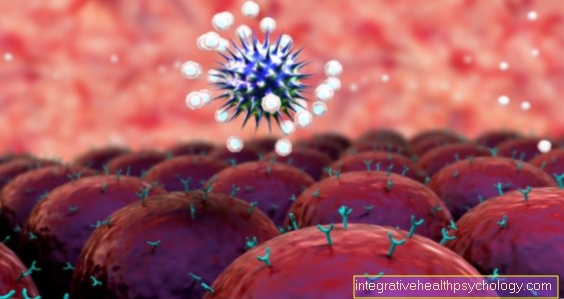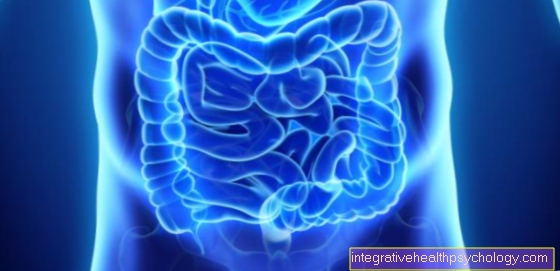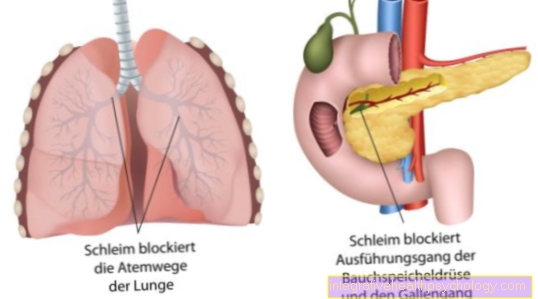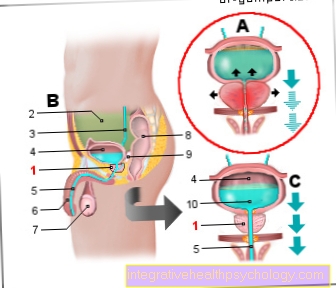Carbamazepine
definition
Carbamazepine is a drug that is mainly used to treat epilepsy. The effectiveness of carbamazepine has also been proven in certain forms of pain - especially so-called neuropathic pain, which occurs due to damage to nerve cells - as well as in mental illnesses such as mania, schizophrenia, bipolar disorders or borderline personality disorder. In this article, however, the use of carbamazepine in epilepsy is mainly examined.

Use in epilepsy
Epilepsy is a disease characterized by frequent epileptic seizures. Such an epileptic seizure can express itself in a wide variety of ways: the spectrum ranges from simple twitching in certain muscle areas to complete mental absence of several seconds (so-called "absenteeism") or olfactory hallucinations with subsequent fainting and cramps up to sudden falls complete loss of tension in all muscles.
Despite the different forms, the formation is always the same: the electrical currents that normally predominate in the brain are replaced by uncontrolled, increased electrical discharges.This causes disorders of consciousness, muscles, movements, thinking, memory or various perceptions.
Which disturbances set in depends on the exact location of these discharges - they can either be limited to a very specific area of the brain or encompass the entire brain and thus e.g. lead to loss of consciousness.
Epileptic seizures usually last only a few seconds to minutes. An exception is the "status epilepticus", in which a series of such seizures strung together for over 30 minutes. Most of these are seizures that involve cramps and are life-threatening due to respiratory paralysis or circulatory disorders.
In general, agents used to treat epilepsy are called "anticonvulsants" or "anti-epileptics". The aim of therapy in epilepsy - including treatment with carbamazepine - is to avoid or at least reduce the number of epileptic seizures. It is important to note that certain types of epileptic seizures trigger changes in the brain that can promote further seizures. It is therefore important for the long-term course to start therapy early. The later it is started, the less often a permanent seizure freedom is achieved. However, this does not have to mean that treatment should be given immediately after the first epileptic seizure - many people have such seizures once in their life without having epilepsy. Typically, treatment is only given from the 2nd attack, with which the diagnosis "epilepsy" is confirmed.
After several years of seizure freedom, an attempt can be made to slowly reduce the dose of the anticonvulsant or the combination of medication and finally stop it. Afterwards, seizures occur in around 40% of adults and 20% of children, with relapse rates differing widely between the different forms of epilepsy and depending on the duration of the illness before treatment.
Carbamazepine is also used in non-epileptics who go through alcohol or drug withdrawal. This prevents possible seizures that can be triggered by withdrawal.
Mechanism of action of carbamazepine
As already described, the root cause of the Seizures in abnormal electrical discharges in the brain. The basis for this are electrically charged particles, so-called ions, which enter the Neurons can flow in and out of the nerve cells.
Carbamazepine works by it Ion channelsthat represent the inputs and outputs for ions, close. In this case it is specifically about Channels for sodium. As a result of this closure, nerve cells lose the opportunity to discharge electrically, often one after the other, and thus to trigger or promote an epileptic seizure.
Carbamazepine works especially for "focal” Seizures Well. Focal means the causative discharges locally on a particular Area are limited in the brain and do not encompass the whole brain. Carbamazepine also has a good effect on people in whom the discharges begin focal and only then spread to the whole brain. However, the absences mentioned above are not affected. In addition to the effect on epilepsy, carbamazepine usually also has one positive influence on the Mood.
Usually it will 2 times a day taken as a tablet. The exact amount can be between approx. 150 and 1000 mg vary - it has to be tried out individually, at what smallest possible amount the seizures disappear. To do this, start with a low dose. It is then gradually increased.
Will the Side effects Too strong - which is often the case - before reaching the required dose alternative drugs how Oxcarbazepine or Lamotrigine getting tested.
Side effects
Common side effects that occur when you start taking it but usually go away later are dizziness, sometimes severe tiredness and a drop in the number of white blood cells, the body's defense cells. The lack of such immune cells can make patients more likely to develop infectious diseases. Double vision and headaches may also occur. The body's salt balance - and in particular the sodium content - can be disrupted, which sometimes means that more water is stored in the body and thus gained weight.
Contrary to the side effects mentioned, a rash and inflammation of the liver due to an allergic reaction may occur regardless of the dose taken.
Very rare, but possible side effects are also psychological changes such as depressive moods, anxiety disorders or aggressiveness.
During the first trimester of pregnancy, carbamazepine should only be taken if there is no alternative to this treatment. Carbamazepine can cause organ malformations in children, albeit mainly minor ones. The risk of such malformations can be reduced by food containing folic acid and by taking folic acid tablets. However, increased folic acid intake must be started 6 months before pregnancy.
After the first trimester of pregnancy, vitamin K should also be taken, as carbamazepine can cause a vitamin K deficiency in the child.
Read more on the subject at: Epilepsy and pregnancy
In addition to the side effects, it is also important with carbamazepine that it interacts with many drugs and can restrict or strengthen their function. Therefore, the simultaneous use of other drugs should be discussed in detail with the doctor.
Use for mental illness
After discovery from Carbamazepine In 1957, epilepsy symptoms and symptoms of mental illnesses caused by epilepsy were also alleviated. That is how it became broad spectrum of activity of carbamazepine more and more clearly.
Typical today is the use at mania. Mania is a disorder that is practically the opposite of depression and created by you exaggerated drive and restlessness is characterized. Mostly she will with lithium treated. The aim is to end a manic phase and prevent another manic phase. If the side effects of lithium are too strong or the effectiveness is too low, carbamazepine is one of the possible alternatives.




















.jpg)








